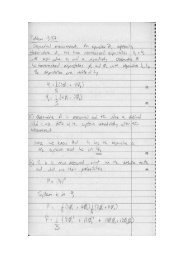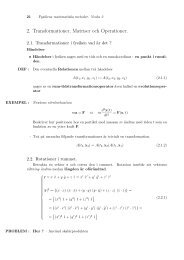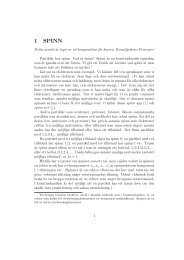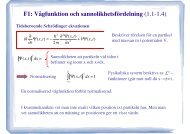1-10 - Fysikum - Stockholms universitet
1-10 - Fysikum - Stockholms universitet
1-10 - Fysikum - Stockholms universitet
You also want an ePaper? Increase the reach of your titles
YUMPU automatically turns print PDFs into web optimized ePapers that Google loves.
GENERAL RELATIVITY<br />
1 Introduction<br />
Lecture notes<br />
by<br />
Kjell Rosquist<br />
<strong>Fysikum</strong>, <strong>Stockholms</strong> <strong>universitet</strong><br />
VT 2011<br />
Galileo demonstrated in his famous experiment in Pisa that particles move on identical spacetime<br />
trajectories in the gravitational field independently of their mass. Newton went further and showed<br />
that the gravitational acceleration of a body does not depend on its composition. This follows from<br />
the formula m1a = Gm1m2r −2 which gives the acceleration (a) of a mass m1 in the gravitational field<br />
of another mass m2 at a distance r (G is Newton’s gravitational constant). By dividing both sides of<br />
the equation by m1 we see that the acceleration of m1 does not depend on the mass m1 itself. The<br />
equality between inertial and gravitational mass is noted more or less as a curious fact in Newtonian<br />
gravity. Einstein, however, regarded this observation as a special case of a more general postulate,<br />
the principle of equivalence, which he took as the basis of general relativity (GR). The principle of<br />
equivalence states that all physical laws if written in tensor form have the same form in any freely<br />
falling reference system. Such a reference frame is by definition a system which is unaffected by all<br />
forces except gravity. Mathematically this means that the theory should be invariant under arbitrary<br />
transformations of the spacetime coordinates. The fundamental observation that the gravitational<br />
interaction does not depend on the mass or composition of a body makes it natural to interpret<br />
gravity as an aspect of the geometry of the spacetime rather than as an ordinary force. In Newtonian<br />
or special relativistic mechanics free particles move along straight lines. Two free particles do not<br />
influence each other (unless they collide). Therefore, in order to describe for example the motion of<br />
the earth in the gravitational field of the sun in geometrical terms we clearly need a more general<br />
concept of geometry than that of ordinary flat Euclidean space. It is here that Riemann’s theory of<br />
1
Kjell Rosquist 8<br />
Figure 4: Differentials in curvilinear coordinates. The vector with components v α at x α<br />
has components v α + dv α at x α + dx α . To take the differential we first parallel transport<br />
the vector from x α to x α + dx α . The transported vector has components v α + δv α .<br />
A scalar is unchanged by parallel transport, δφ = 0, i.e. Dφ = dφ or φ;α = φ,α. We can use this<br />
to derive the change in the components of a covector under parallel transport. Using δ(u α vα) =0we<br />
obtain<br />
Then since the u α are arbitrary it follows that<br />
u α δvα = −vαδu α<br />
= vαu γ Γ α γβdx β<br />
= vγu α Γ γ αβdx β .<br />
(31)<br />
δuα = uγΓ γ αβdx β . (32)<br />
It follows from this that the covariant derivative of a covector is given by<br />
uα;β = uα,β − uγΓ γ αβ . (33)<br />
Next we show that the connection coefficients are symmetric in their lower indices, Γ α βγ =Γ α γβ.<br />
To that end let φ be a scalar and define a covector with components uα = φ,α. Thenuα,β = uβ,α from<br />
which it follows<br />
uα;β − uβ;α = −(Γ γ αβ − Γ γ βα)uγ . (34)<br />
The left hand side of this expression is a tensor. Therefore the right hand side must also be a tensor.<br />
But then the right hand side being zero in Cartesian coordinates must be zero in any coordinate<br />
system. Thus the connection coefficients are symmetric as claimed.<br />
Let us now take a look at the relation between the connection and the metric. The covariant<br />
derivative of the metric is a tensor with components given by<br />
gαβ;γ = gαβ,γ − gδβΓ δ αγ − gαδΓ δ βγ . (35)<br />
In Cartesian coordinates the right hand side is zero. Thus since it is a tensor gαβ;γ = 0 in any<br />
coordinate system. In other words the metric is covariantly constant. We shall express the connection<br />
in terms of the metric by solving (35) as a system of linear equations in Γ α βγ. Definingfirst<br />
we write (35) in three equivalent ways by permuting indices as<br />
Γαβγ = gαδΓ δ βγ , (36)<br />
gαβ,γ =Γαβγ +Γβαγ ,<br />
gγα,β =Γγαβ +Γαγβ ,<br />
−gαβ,γ = −Γβγα − Γγβα ,<br />
(37)


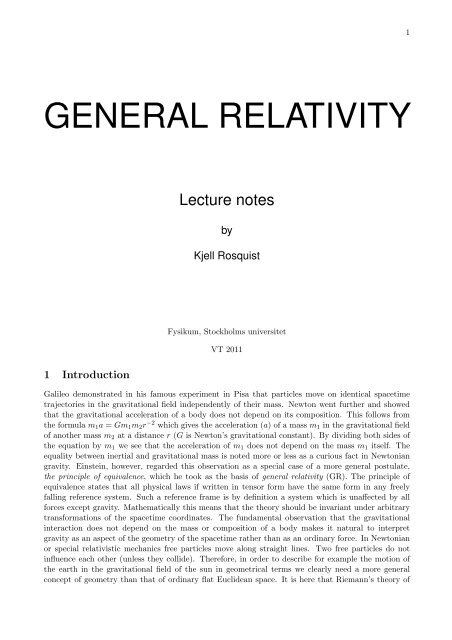
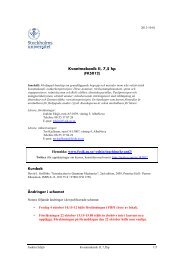
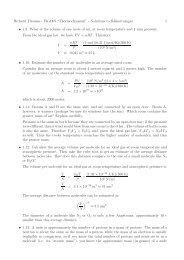
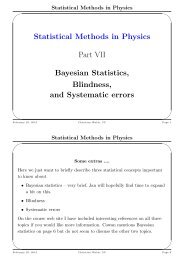
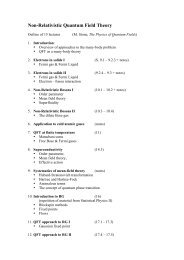
![Final Examination Paper for Electrodynamics-I [Solutions]](https://img.yumpu.com/21085948/1/184x260/final-examination-paper-for-electrodynamics-i-solutions.jpg?quality=85)

